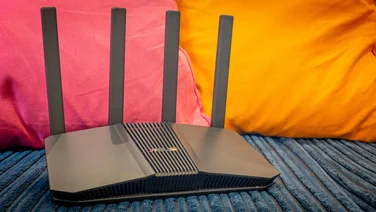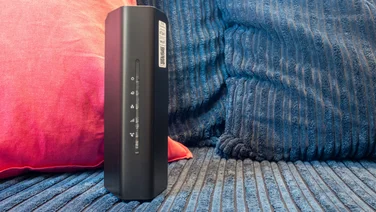To help us provide you with free impartial advice, we may earn a commission if you buy through links on our site. Learn more









- Very fast over 5GHz Wi-Fi 6
- Impressively consistent coverage over a wide area
- Cheaper than most other Wi-Fi 6E systems
- 6GHz network is comparatively slow
- Short on high-end software features
Mesh systems can be expensive, especially once you bring Wi-Fi 6E into the mix. The latest wireless standard extends coverage into the 6GHz radio band to avoid interference and deliver higher speeds, but it requires additional radio and antenna hardware that inevitably drives up the price.
With the Velop Pro 6E, Linksys has sought to keep the price as low as possible. It isn’t exactly a pocket-money purchase, but at £380 for two stations it’s far cheaper than most 6E-enabled meshes we’ve seen, and it promises wide-area coverage that should fill a decently sized home with rock-solid Wi-Fi.
The deal comes with one trade-off: wireless speeds on the 6GHz band are rather mediocre. Thankfully, the Velop Pro 6E redeems itself by delivering superb download speeds over ordinary Wi-Fi 6 – so if you have the money to spend, it’s a great way to get a strong, fast connection for all your devices, rather than just the 6E-compatible ones.
READ NEXT: The best meshes we’ve tested
Linksys Velop Pro 6E mesh review: What you need to know
The Velop Pro 6E comes as a pack of either two or three mesh units. The stations are all identical; one plugs into your internet connection (replacing your old router) while the others sit in other rooms and act as extenders.
Linksys claims the mesh system can handle up to 200 connected devices, with each unit covering an area of up to 280 square metres. That means two stations should be enough for a typical household, although it’s good to have the three-pack option for mansion-dwellers, or those who need to project a network around an awkwardly shaped property.

Inside each Velop unit, there’s a 2.4GHz transceiver that can communicate with legacy devices and smart home appliances at up to 600Mbits/sec, while the 5GHz and 6GHz radios both support connections at up to 2.4Gbits/sec. On both bands this is achieved using 2×2 MU-MIMO, so one device can take advantage of the full available bandwidth, or two devices can share it.
While these are good numbers, it’s worth noting that there’s no separate radio for backhaul communications. This helps keep the price down, but it also means your browsing and streaming activity have to share airtime with station-to-station traffic, which will impact the connection speeds you see.
Linksys Velop Pro 6E mesh review: Price and competition
Linksys advertises the Velop Pro 6E as “one of the most affordable Wi-Fi 6E systems on the market”, and that’s a fair claim. The two-unit system launches at £380, while a pack of three costs £500.
Very few other 6E-equipped meshes can compete with this pricing. You could get a three-unit Google Nest WiFi Pro system for the same money – but as we’ve seen in our review, that mesh offers disappointing performance.
Elsewhere, the TP-Link Deco XE200 offers impressive speeds at a much higher price – we’re talking £800 for two stations. And, at the top of the pile, the Netgear Orbi RBKE963 achieves exceptional performance thanks to its quad-band design, but the price is hard to justify: you’ll pay £1,200 for two Orbi stations, or £1,700 for three.

The most tempting 6E-enabled alternative to the Velop Pro 6E is the TP-Link Deco XE75. Originally released in September 2022, this mesh delivers strong speeds on the 6GHz band, and is currently heavily discounted on Amazon, down from an original price of £500 to just £340 for three stations.
Since the Velop Pro 6E performs best on the 5GHz band, you could also compare it to a regular Wi-Fi 6 mesh. The Netgear Orbi RBK763 is one of the best tri-band 5GHz systems around, but at £420 for two stations it’s distinctly pricier than the Velop. Another option is the Huawei Mesh 7; at £330 this undercuts the Linksys mesh on price, but it can’t match the top speeds of the Velop. You pays your money and takes your choice.
READ NEXT: The best wireless routers to buy right now
Linksys Velop Pro 6E mesh review: Design and features
Like previous Velop systems, the Velop Pro 6E units are plain white towers. They’re substantial but not too chunky, standing 196mm tall with a 95mm square footprint; this particular model is distinguished by a squared-off corner, which adds a little character without signifying anything in particular, plus some jaunty venting around the top.
Aside from those small touches of style, there’s not much else to see. The multicoloured status LED is just a small dot on the top of each unit, while on the rear you get a pair of Ethernet sockets. Presumably in the name of economy, these are both limited to gigabit speeds, and Linksys also saves money by using identical labelling on every station, so the lower socket on each Velop unit is marked “Internet” – even though satellite stations use both ports for LAN connections.
On the base, you’ll find a power switch, a WPS button and a pinhole reset button. There are no other controls or connectors, and despite the angular design, these units officially don’t support wall-mounting.

As usual with Linksys, setup is carried out via the mobile app. This could hardly be simpler: the app prompts you to create a Linksys account if you don’t already have one (or to log in if you do), then detects your new Velop network and prompts you to give it a new name and passphrase. Everything else it takes care of itself.
After this you can use the same app to monitor and manage the network. With a few taps, you can browse connected devices, turn the guest network on and off and change your Wi-Fi password. Delve into the advanced features and you can also adjust your DHCP settings and set up port forwarding.
There’s little in the way of power-user features, but a speed-test tool lets you measure the link speed between the router and your ISP, and a very simple QoS feature lets you nominate up to three priority devices, which get first dibs at internet bandwidth. The parental controls are similarly rudimentary: you can set schedules for when individual devices are allowed to connect to the internet, but website filtering is limited to a blocklist of ten URLs, which you’ll have to enter by hand. And if you’re looking for network security scanning or VPN support, you’re wholly out of luck.

After initial configuration, it’s also possible to manage the Linksys Velop Pro 6E via a desktop browser. However, this uses Linksys’ ancient “Smart Wi-Fi” interface, which is sluggish and somewhat awkward to navigate. It does have a few low-level features the app lacks, such as static routing and dynamic DNS support, but you’ll probably want to stick with the app for everyday administration.
Linksys Velop Pro 6E mesh review: Performance
To test the Linksys Velop Pro 6E’s performance I set up the system in my own home – a split-level three-bedroom maisonette in inner London. I installed the primary Velop station in my study, connected directly to my ISP line, with a second in the adjoining bedroom and a third in the downstairs living room.
I then attached an Asustor Drivestor 4 Pro NAS appliance to the main Velop unit via gigabit Ethernet, carried my test laptop – equipped with an Intel AX210 Wi-Fi 6E wireless card – to various areas of my home, and measured average transfer speeds when copying files to and from the NAS.
Each test was carried out four times. The Velop Pro 6E broadcasts separate networks on the 5GHz and 6GHz bands, so I tested performance on each of these. I also repeated each test with the living-room node switched off, to see whether the third station has any benefit in a medium-sized home. I was pleased to see no difference in performance between two-node and three-node configurations, confirming that two Velop units are ample for a medium-sized home.


Here are the results I saw, along with speeds from some competing mesh systems:As you can see, the Velop Pro 6E achieved much better download speeds on the 5GHz network than over a 6GHz connection. That probably indicates that the system is using the 6GHz network for backhaul, meaning there’s less bandwidth available for client devices using this frequency range.
This isn’t a problem, though, as you can simply connect your devices to the 5GHz network instead – and when you do this, the Velop delivers impressively consistent, very fast performance. With at least 69MB/sec downstream in every room of my home, it served up enough bandwidth to fully saturate a 500Mbits/sec internet connection. Its download speeds left 5GHz-only rivals in the dust, far outpacing the Huawei Mesh 7.
Indeed, the Velop Pro 6E’s performance on the 5GHz band was so strong it gave the 6GHz-equipped TP-Link Deco XE75 a convincing run for its money. The only meshes that were able to convincingly beat it were the TP-Link Deco XE200 and the Netgear Orbi RBK963E – both much more expensive systems.
Linksys Velop Pro 6E mesh review: Verdict
The Velop Pro 6E isn’t necessarily the right mesh for everyone. The sort of performance it offers is massive overkill for everyday web browsing, and even for working from home; a cheap Wi-Fi 6 mesh such as the Mercusys Halo H80X will meet most people’s needs for a third of the price.
The system has a few of its own weaknesses, too: the firmware is short on advanced features, and it would have been nice to get some multi-gigabit Ethernet ports to make the most of that stellar wireless performance.
Even so, if you’re looking for a high-speed Wi-Fi mesh at around the £400 mark, the Linksys Velop Pro 6E might well be your best option. While it won’t wring the very fastest possible speeds from your Wi-Fi 6E-compatible devices, it provides superb coverage for all Wi-Fi 6 clients, with performance that you simply won’t find anywhere else at this price.







